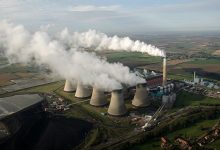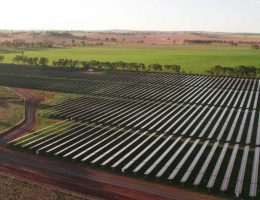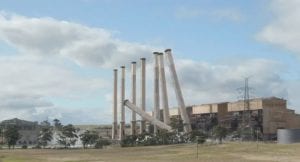Australia’s greenhouse gas emissions remained flat in the latest quarterly update to emissions data released by the federal government, but the climate politics in federal parliament hit a new low as the Coalition government and its MPs launched extraordinary attacks against Labor’s proposed zero carbon targets for 2050.
The latest data also solicited an extraordinary display of double think from federal energy minister and emissions reduction minister Angus Taylor, who argued that Australia’s emissions were in fact going down, as long as you ignored the bits that were going up.
The updated data released by the federal government shows that Australia’s emissions remained unchanged in the third quarter of 2019, as falls from the electricity sector, thanks to the growing amount of wind and solar, and reductions in agricultural output were offset by increases in emissions from stationary energy, fugitive emissions, transport and land-use change.
The recent surge in investment in new wind and solar projects helped electricity emissions fall by 2.0 per cent in the year to September 2019, and the amount of coal generation continued its precipitous fall.
Drought and flooding across Australia’s eastern states, made worse by climate change, have led to a substantial reduction in agricultural output due to reduced cattle herds and in turn as led to a 5.8 per cent reduction in agricultural emissions in the year to September 2019, but is not an outcome the Morrison government would wish to celebrate given the impacts on farmers.
A massive ramp-up in liquified natural gas production has seen Australia’s fugitive emissions increase by 6.1 per cent in the year to September 2019, as increased gas extraction as led to increases in the amount of methane being lost to the atmosphere.
Additionally, the use of diesel, primarily used in heavy road transport and the movement of resources such as iron ore, has increased by around 70 per cent since over the decade, which as driven up Australia’s transport emissions.
On an annualised basis, Australia’s emissions fell by 0.3 per cent in the year to September 2019, continuing a period of a flat trend in Australia’s greenhouse gas emissions since 2013. The updated data shows that Australia’s greenhouse gas emissions have fallen just 1.26 per cent in the six years since the Liberal-National coalition formed government in September 2013.
Going back further, the updated dataset shows emissions are almost where they were almost 20 years ago, and have fallen a total of just 1.01 per cent since 2000.
Taylor told ABC’s RN Breakfast program that Australian’s should effectively ignore emissions associated with Australia’s exports and agricultural sectors when considering Australia’s stalled emissions reductions.
“The challenge here is our exports have been growing absolutely gangbusters and they have been since we got into government. We’ve developed the world’s largest LNG export sector, and that’s reducing emissions in China in Japan and Korea,” Taylor said.
“When you take out our exports, if we take out our farming exports, for instance, as well as our LNG exports, domestic emissions are dropping by over 2 per cent.
“That’s a very strong result and at the centre of that is a 3.2 per cent reduction in emissions in the electricity grid. We’ve talked about challenges that’s creating but it is bringing down emissions at a very rapid pace.”
Labor energy spokesperson Mark Butler said that updated data highlighted the lack of action from the Morrison government towards reducing Australia’s greenhouse gas emissions.
“There was no reduction in emissions in the quarter to September 2019 and annual emissions only reduced by a pitiful 0.3 per cent year to date – driven by the effect of the drought and the final investment to meet Labor’s Renewable Energy Target,” Butler said.
“In fact, emissions reduction will amount to little more than a rounding error of 0.3 per cent, putting the lie to the Prime Minister’s claim that we are meeting and beating our international commitments.”
“The Government’s own data suggests emissions will come down during the next 10 years by only less than 5 per cent. At that rate, it will take Australia 230 years to reach net zero emissions, rather than the 30 years scientists tell us is necessary,” Butler added.
This was a point echoed by Australian Conservation Foundation CEO Kelly O’Shanassy.
“Flatlining emissions is not good enough,” O’Shanassy said.
“In this latest data we’re seeing the impacts of climate change – especially the devastating drought – hitting Australia’s farmers hard, resulting in fewer emissions from that sector.”
“To keep digging and burning fossil fuels will condemn Australians to many more and worse bushfire seasons, more extreme heatwaves and water shortages. We have to have much stronger targets to cut climate pollution and a credible plan to get us to those goals,” O’Shanassy added.
The updated greenhouse gas emissions data, showing stalled reductions, comes as Angus Taylor labelled Labor’s recommitment to a net zero emissions target by 2050 as “silly”.
More than 70 countries, including Canada, the United Kingdom, New Zealand and the European Union have committed to a net zero emissions target by 2050, and is a target that as won the support of the Business Council of Australia and major resources company BHP.

As billionaire Mike Cannon-Brookes points out, the zero carbon target is implicit in the Paris climate treaty that Australia signed up to in 2015.
In response to Labor’s re-endorsement of the long term target, Taylor said the government would not sign up to a net zero emissions target without a plan.
NT Country Liberal senator Sam McMahon went further, saying Australians didn’t want to live in “mud huts” without electricity, and Liberal MP Craig Kelly reckons he did a “rough calculation” that concluded Australia would need about 140 nuclear reactors to replace its coal and gas plants.












